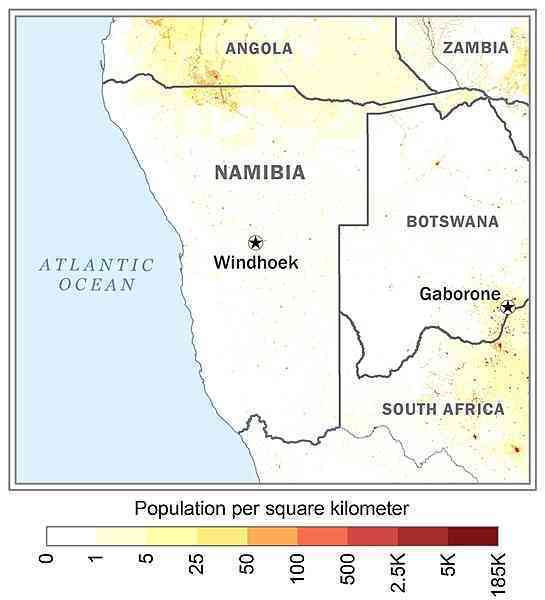
Southern Africa, bordering the South Atlantic Ocean, between Angola and South Africa
22 00 S, 17 00 E
Africa
total: 824,292 sq km
land: 823,290 sq km
water: 1,002 sq km
almost seven times the size of Pennsylvania; slightly more than half the size of Alaska
total: 4,220 km
border countries (4): Angola 1,427 km; Botswana 1,544 km; South Africa 1,005 km; Zambia 244 km
1,572 km
territorial sea: 12 nm
contiguous zone: 24 nm
exclusive economic zone: 200 nm
desert; hot, dry; rainfall sparse and erratic
mostly high plateau; Namib Desert along coast; Kalahari Desert in east
highest point: Konigstein on Brandberg 2,573 m
lowest point: Atlantic Ocean 0 m
mean elevation: 1,141 m
diamonds, copper, uranium, gold, silver, lead, tin, lithium, cadmium, tungsten, zinc, salt, hydropower, fish; note - suspected deposits of oil, coal, and iron ore
agricultural land: 47.2% (2018 est.)
arable land: 1% (2018 est.)
permanent crops: 0% (2018 est.)
permanent pasture: 46.2% (2018 est.)
forest: 8.8% (2018 est.)
other: 44% (2018 est.)
80 sq km (2012)
Zambezi (shared with Zambia [s]), Angola, Botswana, Zimbabwe, and Mozambique [m]) - 2,740 km; Orange river mouth (shared with Lesotho [s], and South Africa) - 2,092 km; Okavango (shared with Angola [s], and Botswana [m]) - 1,600 km
note – [s] after country name indicates river source; [m] after country name indicates river mouth
Atlantic Ocean drainage: Orange (941,351 sq km)
Indian Ocean drainage: Zambezi (1,332,412 sq km)
Internal (endorheic basin) drainage: Okavango Basin (863,866 sq km)
Lower Kalahari-Stampriet Basin, Upper Kalahari-Cuvelai-Upper Zambezi Basin
population density is very low, with the largest clustering found in the extreme north-central area along the border with Angola as shown in this 
prolonged periods of drought
the Namib Desert, after which the country is named, is considered to be the oldest desert in the world; Namibia is the first country in the world to incorporate the protection of the environment into its constitution; some 14% of the land is protected, including virtually the entire Namib Desert coastal strip; Namib-Naukluft National Park (49,768 sq km), is the largest game park in Africa and one of the largest in the world
NOTE: The information regarding Namibia on this page is re-published from the 2024 World Fact Book of the United States Central Intelligence Agency and other sources. No claims are made regarding the accuracy of Namibia 2024 information contained here. All suggestions for corrections of any errors about Namibia 2024 should be addressed to the CIA or the source cited on each page.
This page was last modified 04 May 24, Copyright © 2024 ITA all rights reserved.